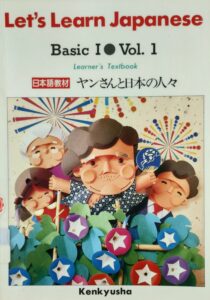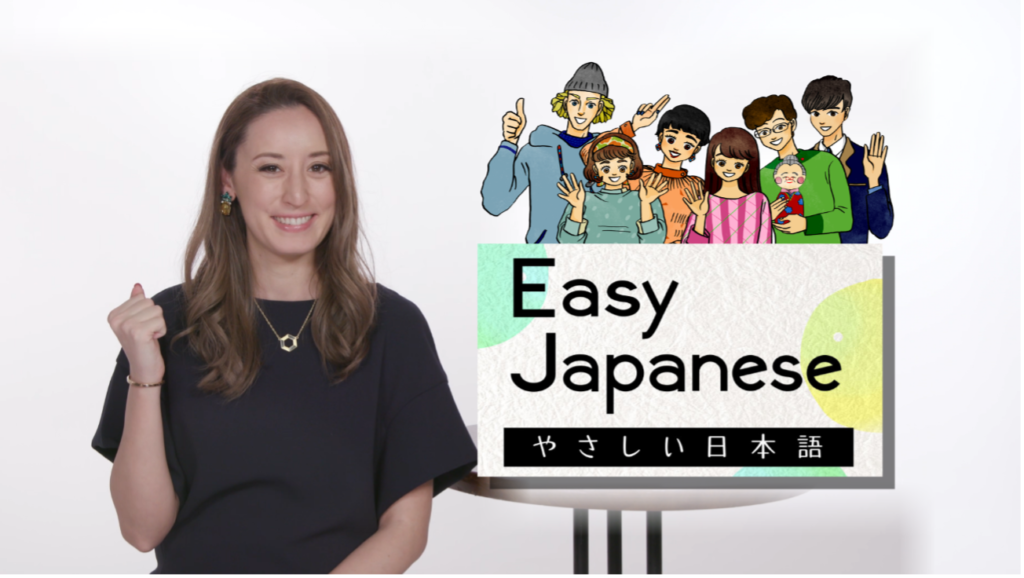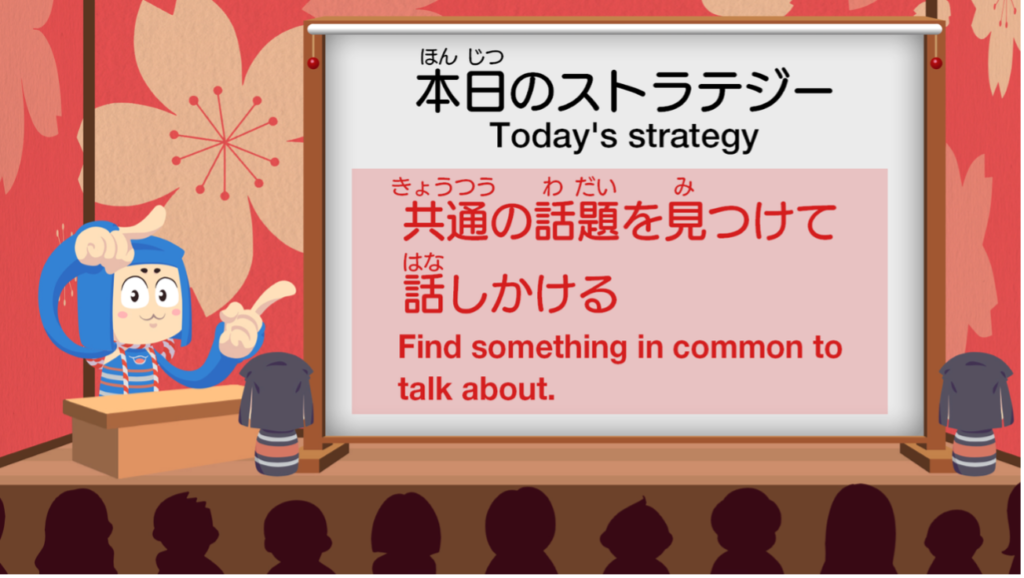2022.12.28
LANGUAGEWhat is Needed to Communicate Effectively?
The Path to Mutual Understanding as Shown by Japanese Language Learning Video Materials
.png)
The Japan Foundation has been producing Japanese language learning video materials based on the principle of deepening mutual understanding through language communication. They are filled with important communication tips for Japanese people as well.
When you cannot remember the suitable word clearly, when you want to get along with someone, or when there is someone having trouble understanding complex instructions… What would you do? In Japanese language education, concepts called “strategies” are used to effectively communicate in such situations. They include “replace the part you cannot recall with ‘nantoka,’” “find something in common to talk about,” and “rephrase (complex instructions) in short, simple sentences.”
Focusing on these “strategies,” the Japan Foundation (JF), in collaboration with NHK Educational, has developed its latest Japanese language education program, “Hikidasu Nihongo: Activate Your Japanese!” The program began airing on NHK WORLD-JAPAN in 2022. The main section of the program is the drama “Xuan Tackles Japan!” In it, the main character Xuan, who comes from Vietnam to work in Japan, overcomes minor difficulties and answers queries that she encounters in her daily life and work by using strategies appropriate to the situation.
A variety of teaching materials have been produced that focus on specific Japanese conversations for use in the workplace. This is in response to the introduction of the Specified Skilled Worker program, a new policy for accepting foreign nationals. However, simply learning conversations and expressions that can be used only in specific scenarios will not help you communicate well in unexpected situations. It is also not realistic to create teaching materials that cover all occupations in which foreigners work. With this in mind, JF decided to focus on strategies that can be applied to any situation and create teaching materials that “draw out (hikidasu)” the ability to communicate in Japanese.
Communication-oriented Attitude Underlying JF’s Teaching Materials
The development of teaching materials focused on communication did not originate from the Specified Skilled Worker program. Neither did it only start after 2010, when JF released the JF Standard for Japanese-Language Education as a new framework for Japanese language learning. Since its early days in the 1970s, JF has produced a variety of Japanese language materials with mutual understanding and communication skills in mind. The content and methods in the materials strongly reflect the needs and social background of each era, as well as the latest research findings.
“Kore wa Yan-san no nimotsu desu ka? (Is this your luggage, Mr. Yan?)”
“Ee, kore wa watashi no desu. (Yes, this is mine.)”
“Ara, kore wa watashi no dewa arimasen. (Oh no, this isn’t mine.)”
“Ja, kore wa dare no desu ka? (So, whose is it?)”
This is a scene from “Mr. Yan and the People of Japan,” which was developed by JF in 1983 with a total of 13 episodes as the first systematic video teaching material. This conversation takes place when Mr. Yan, a foreign architect who has arrived in Japan from overseas, is putting back his luggage, which has been scattered after bumping into someone at the airport, while checking them one by one. The basic Japanese expression, “Kore wa XYZ-san no desu. (This is Mr./Ms. XYZ’s.)” is incorporated into the drama as natural and practical communication.
Around the year 1983, when “Mr. Yan” was produced, there was much discussion in the field of applied linguistics about the shift from knowledge-oriented language learning to communication-oriented language learning. JF, which until the mid-1980s had been producing exclusively paper-based teaching materials, also decided to develop video materials that could convey more information at once than text using movement and sound. This was to help respond to questions from overseas learners, such as “In what situations is this Japanese expression actually used?” “What is the Japanese society, lifestyle, and culture like lying behind it?” “Mr. Yan and the People of Japan” is a teaching material that reflects the most advanced research of its time, and as a pioneer in Japanese language video teaching materials, it was highly acclaimed by many Japanese language educators and learners.

“Mr. Yan and the People of Japan” became popular when it was used in the “TV Japanese language course (Let’s Learn Japanese)” that aired in North America, Australia, China, Brazil, Southeast Asia and elsewhere, and a sequel was produced in 1996.
In the 21st century, now that digital technology has advanced dramatically, the trend toward teaching materials that focus mainly on video format has accelerated even further.
In the early 2000s, for example, elements of Japanese pop culture such as manga and anime triggered a rapid increase in the number of young people overseas interested in the Japanese language. Also, Japanese language education was introduced at the secondary school level, largely in Southeast Asia. It was then that JF began developing the Japanese language study program “Erin’s Challenge! I can speak Japanese.” Its main character is a high school overseas student close to the age of learners. Since its first broadcast on NHK TV in 2006, it has continued to be used around the world as video content for learning Japanese.

-1024x681.jpg)
The realistic school drama “Erin’s Challenge! I can speak Japanese” is about an overseas student, Erin, played by TOYOTA Ellie, and her classmates, played by KURASHINA Kana and others. It was aired on NHK Educational TV, and later spread to various countries and regions. Three DVD volumes were released in 2007, and an online version was made available in 2010.
In 2014, JF also produced a free English-explanation, e-learning material, “Nihongo Starter,” in collaboration with the Open University of Japan. Reflecting the government’s active acceptance of overseas students at the time, including those in science and engineering, the skit was set at a science and engineering university with a host character called “Robojii (Robot grandpa).” This teaching material sets goals that are relevant to the lives of college students, such as “greeting each other” and “talking with friends about where to eat lunch together.” Through this e-learning material, learners could learn Japanese from anywhere, anytime regardless of location.
Furthermore, from 2018, JF has supervised the latest series of “Easy Japanese,” a Japanese language study program aired and disseminated over many years on NHK WORLD-JAPAN. As the number of foreign tourists visiting Japan increases every year, the program set up each skit in a situation that they are likely to encounter in Japan. It is characterized by showing what they will be able to do after leaning the program in an easy-to-understand manner by presenting a goal for each skit as “can-do”.

“Easy Japanese” is a three-minute TV program series. It includes plenty of content, such as a drama-like story skit set in a share house in Tokyo, explanations of key phrases, and lifestyle and travel information.
Overcoming Language Barriers to Create a Better Society Together
In 2022, “Hikidasu Nihongo: Activate Your Japanese!”—introduced previously—was born in response to new initiatives at the national level for the acceptance and coexistence of foreign nationals. MIZUTANI Yoko, a producer at NHK Educational, was involved in the joint production with JF. “It is not often the case that a language learning program focuses on strategies,” she said in an interview with JF’s web magazine “Wochi Kochi.” “(Different from teaching vocabulary and grammar,) the way to apply the information that you provide to students is different in different situations, and there can be different interpretations and no right answers, and it was actually very difficult to make such things into a program.”
Nevertheless, JF continued to focus on “strategies.” JF believed that the ability that modern language learners needed was one of achieving communication goals by utilizing the knowledge of Japanese language and various skills that they already have, even in unexpected situations. “This is a hurdle that language learners always seem to run into. There is no doubt that by getting over this hurdle, students can proceed to the next step. So I wanted to make a program about that.”

The “strategies” introduced in “Hikidasu Nihongo: Activate your Japanese!” are filled with little tricks of verbal communication. The content is useful not only for foreigners learning Japanese, but also for Japanese people. ©2022 The Japan Foundation / NHK Educational Corporation
Fonchi, who plays the main character Xuan, is a native Japanese speaker born and raised in Japan by Vietnamese parents. She says that she played the role of Xuan while keeping in mind the perspectives of both foreigners and Japanese people. “I have heard that the number of foreign workers is increasing, not only those from Vietnam. Also, there are many people working in Japan to send money to their families in their home countries or to save up for their dreams for the future. I was born and raised in Japan, but as someone of foreign descent, I am not exactly a stranger to how people coming to Japan for the first time feel, and I would like to help them, even if only a little. So, I actually do teach the convenience store clerk one or two Japanese words once in a while. Through this program, I feel more strongly than before that I should try to treat such people around me with kindness and warmth.”
As more and more foreigners live and work in Japan, how can we promote mutual understanding toward a better society that emphasizes harmonious coexistence? Those involved in Japanese language education are thinking about the abilities required for modern communication and are constantly developing teaching materials through trial and error. For the Japanese people working with foreigners, Xuan’s many episodes will provide hints for creating a society that is easy for everyone to live in.
*Reference for MIZUTANI Yoko and Fonchi’s comments here.
Living Together with Japanese Language <1> Interview with Lead Actor Fonchi and the Production Team of “ひきだすにほんご Activate Your Japanese!” What Activates Our Communications (Part 1)
Living Together with Japanese Language <2> Interview with Lead Actor Fonchi and the Production Team of “ひきだすにほんご Activate Your Japanese!” What Activates Our Communications (Part 2)
【Related pages】
Learning Japanese Changed My Life—A Passport to the Future Gained through Japanese Language Learning
A Second Home for Overseas Japanese Language Teachers, Training Programs Offered by the Japanese-Language Institute, Urawa
As Japanese-Language Learners are Growing in Asia, Responding to the Diversifying Learning Motives There
“NIHONGO Partners,” Bringing Living Language and Culture to Middle and High-School Students Studying Japanese in Asia
The Japan Foundation Prizes for Global Citizenship—Linking the Regions of Japan with the World
